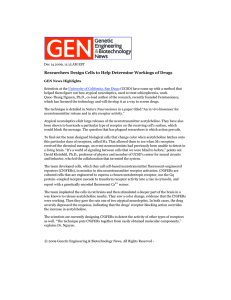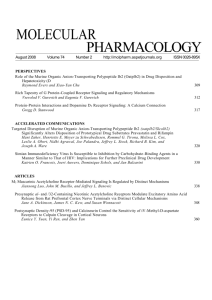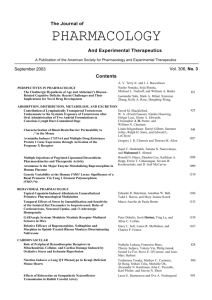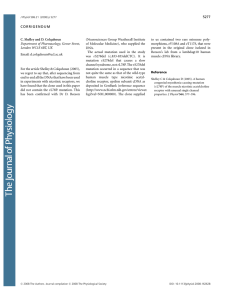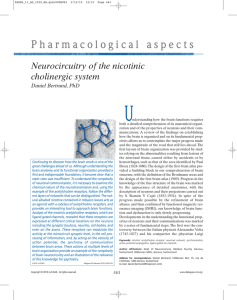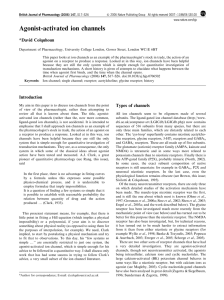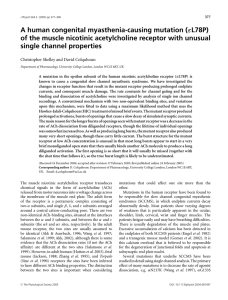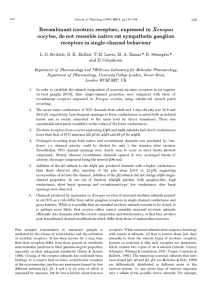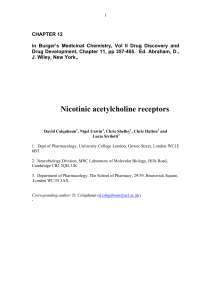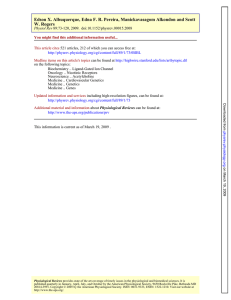Perceptions of
advertisement
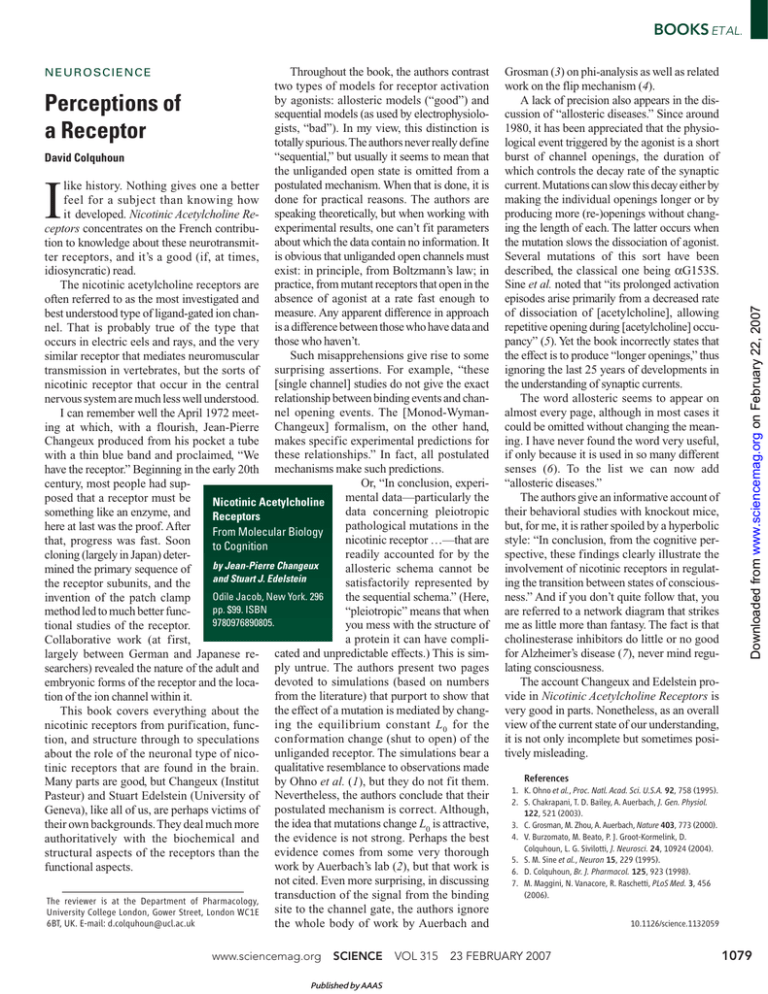
Throughout the book, the authors contrast two types of models for receptor activation by agonists: allosteric models (“good”) and sequential models (as used by electrophysiologists, “bad”). In my view, this distinction is totally spurious. The authors never really define “sequential,” but usually it seems to mean that David Colquhoun the unliganded open state is omitted from a like history. Nothing gives one a better postulated mechanism. When that is done, it is feel for a subject than knowing how done for practical reasons. The authors are it developed. Nicotinic Acetylcholine Re- speaking theoretically, but when working with ceptors concentrates on the French contribu- experimental results, one can’t fit parameters tion to knowledge about these neurotransmit- about which the data contain no information. It ter receptors, and it’s a good (if, at times, is obvious that unliganded open channels must exist: in principle, from Boltzmann’s law; in idiosyncratic) read. The nicotinic acetylcholine receptors are practice, from mutant receptors that open in the often referred to as the most investigated and absence of agonist at a rate fast enough to best understood type of ligand-gated ion chan- measure. Any apparent difference in approach nel. That is probably true of the type that is a difference between those who have data and occurs in electric eels and rays, and the very those who haven’t. Such misapprehensions give rise to some similar receptor that mediates neuromuscular transmission in vertebrates, but the sorts of surprising assertions. For example, “these nicotinic receptor that occur in the central [single channel] studies do not give the exact nervous system are much less well understood. relationship between binding events and chanI can remember well the April 1972 meet- nel opening events. The [Monod-Wymaning at which, with a flourish, Jean-Pierre Changeux] formalism, on the other hand, Changeux produced from his pocket a tube makes specific experimental predictions for with a thin blue band and proclaimed, “We these relationships.” In fact, all postulated have the receptor.” Beginning in the early 20th mechanisms make such predictions. Or, “In conclusion, expericentury, most people had supmental data—particularly the posed that a receptor must be Nicotinic Acetylcholine data concerning pleiotropic something like an enzyme, and Receptors pathological mutations in the here at last was the proof. After From Molecular Biology nicotinic receptor …—that are that, progress was fast. Soon to Cognition readily accounted for by the cloning (largely in Japan) deterby Jean-Pierre Changeux allosteric schema cannot be mined the primary sequence of and Stuart J. Edelstein satisfactorily represented by the receptor subunits, and the Odile Jacob, New York. 296 the sequential schema.” (Here, invention of the patch clamp pp. $99. ISBN “pleiotropic” means that when method led to much better func9780976890805. you mess with the structure of tional studies of the receptor. a protein it can have compliCollaborative work (at first, largely between German and Japanese re- cated and unpredictable effects.) This is simsearchers) revealed the nature of the adult and ply untrue. The authors present two pages embryonic forms of the receptor and the loca- devoted to simulations (based on numbers from the literature) that purport to show that tion of the ion channel within it. This book covers everything about the the effect of a mutation is mediated by changnicotinic receptors from purification, func- ing the equilibrium constant L 0 for the tion, and structure through to speculations conformation change (shut to open) of the about the role of the neuronal type of nico- unliganded receptor. The simulations bear a tinic receptors that are found in the brain. qualitative resemblance to observations made Many parts are good, but Changeux (Institut by Ohno et al. (1), but they do not fit them. Pasteur) and Stuart Edelstein (University of Nevertheless, the authors conclude that their Geneva), like all of us, are perhaps victims of postulated mechanism is correct. Although, their own backgrounds. They deal much more the idea that mutations change L0 is attractive, authoritatively with the biochemical and the evidence is not strong. Perhaps the best structural aspects of the receptors than the evidence comes from some very thorough work by Auerbach’s lab (2), but that work is functional aspects. not cited. Even more surprising, in discussing transduction of the signal from the binding The reviewer is at the Department of Pharmacology, site to the channel gate, the authors ignore University College London, Gower Street, London WC1E 6BT, UK. E-mail: d.colquhoun@ucl.ac.uk the whole body of work by Auerbach and NEUROSCIENCE Perceptions of a Receptor I www.sciencemag.org SCIENCE Published by AAAS VOL 315 Grosman (3) on phi-analysis as well as related work on the flip mechanism (4). A lack of precision also appears in the discussion of “allosteric diseases.” Since around 1980, it has been appreciated that the physiological event triggered by the agonist is a short burst of channel openings, the duration of which controls the decay rate of the synaptic current. Mutations can slow this decay either by making the individual openings longer or by producing more (re-)openings without changing the length of each. The latter occurs when the mutation slows the dissociation of agonist. Several mutations of this sort have been described, the classical one being αG153S. Sine et al. noted that “its prolonged activation episodes arise primarily from a decreased rate of dissociation of [acetylcholine], allowing repetitive opening during [acetylcholine] occupancy” (5). Yet the book incorrectly states that the effect is to produce “longer openings,” thus ignoring the last 25 years of developments in the understanding of synaptic currents. The word allosteric seems to appear on almost every page, although in most cases it could be omitted without changing the meaning. I have never found the word very useful, if only because it is used in so many different senses (6). To the list we can now add “allosteric diseases.” The authors give an informative account of their behavioral studies with knockout mice, but, for me, it is rather spoiled by a hyperbolic style: “In conclusion, from the cognitive perspective, these findings clearly illustrate the involvement of nicotinic receptors in regulating the transition between states of consciousness.” And if you don’t quite follow that, you are referred to a network diagram that strikes me as little more than fantasy. The fact is that cholinesterase inhibitors do little or no good for Alzheimer’s disease (7), never mind regulating consciousness. The account Changeux and Edelstein provide in Nicotinic Acetylcholine Receptors is very good in parts. Nonetheless, as an overall view of the current state of our understanding, it is not only incomplete but sometimes positively misleading. Downloaded from www.sciencemag.org on February 22, 2007 BOOKS ETAL. References 1. K. Ohno et al., Proc. Natl. Acad. Sci. U.S.A. 92, 758 (1995). 2. S. Chakrapani, T. D. Bailey, A. Auerbach, J. Gen. Physiol. 122, 521 (2003). 3. C. Grosman, M. Zhou, A. Auerbach, Nature 403, 773 (2000). 4. V. Burzomato, M. Beato, P. J. Groot-Kormelink, D. Colquhoun, L. G. Sivilotti, J. Neurosci. 24, 10924 (2004). 5. S. M. Sine et al., Neuron 15, 229 (1995). 6. D. Colquhoun, Br. J. Pharmacol. 125, 923 (1998). 7. M. Maggini, N. Vanacore, R. Raschetti, PLoS Med. 3, 456 (2006). 23 FEBRUARY 2007 10.1126/science.1132059 1079
